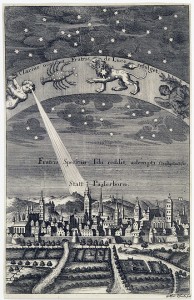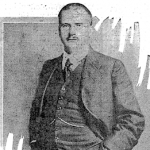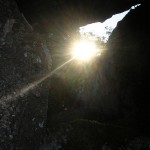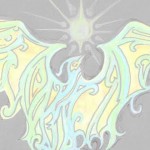If someone were to ask you, ‘What did Aleister Crowley, Gerald Gardner, Dion Fortune, Doreen Valiente, Kenneth Grant, and Margot Adler have in common?’, you might reply that they were all authors, or that they were all important contributors to the revival of Paganism and the occult. Another answer could be that they all quote the words of Carl Gustav Jung in their work. Why Jung and why did he seem important to them?
Aleister Crowley (1875–1947) was born in the same year as Jung, and he lived through the same World Wars and the same radical changes in western culture and society. From Thelema to analytical psychology may seem a great leap, but Crowley was an early reader of Jung. In 1919, there were two books that helped him write ‘a formidable treatise of some forty-five thousand words.’ These were Sir James Frazer’s The Golden Bough and Carl Jung’s Psychology of the Unconscious (Crowley, 1979 ed., p. 809).
What appealed to the great magician about Jung’s work? Crowley was not a fan of psychoanalysis, but by the end of 1916 he was writing in the American edition of Vanity Fair:
We ought not to be surprised to learn that Dr Jung of Zürich balked at some of Freud’s conclusions. Instead of relating will to sex, he related sex to will. Thus, all unconsciously, he has paved the way for a revival of the old magical idea of the will as the dynamic aspect of the self. Each individual, according to the initiates, has his own definite purpose, and assumes human form, with its privileges and penalties, in order to execute that purpose. This truth is expressed in magical language by the phrase ‘Every man and every woman is a star’… (Crowley, 1916)
Finding the centre
For Crowley, Jung’s work leads to the same conclusions as his own – that each one of us has a purpose in incarnation. Crowley expressed this in terms of finding one’s True Self, or True Will. In Jung’s language, this inner goal is ‘individuation’ and the end-result is finding the ‘self’.
I have called this wholeness that transcends consciousness the ‘self’. The goal of the individuation process is the synthesis of the self. (Jung, 1940, pp. 164, para. 278)
For Jung the self is the deeper self:
… a consciousness which is no longer imprisoned in the petty, over sensitive, personal world of the ego, but participates freely in the wider world of objective interests. … bringing the individual into absolute, binding, and indissoluble communion with the world at large. (Jung, 1916/1928/1934, pp. 178, para. 275)
This is not the everyday ‘I’ that we see in the mirror each morning. It is not the product of this incarnation, though this incarnation contributes to it. Rather it is the ‘self’ that Hindu teaching calls ‘atman’, our deepest and enduring core.
The process of attaining the self, involves a shift of the centre of consciousness from that of the ego to that of the self. This is achieved by opening ourselves to those parts of our psyches that are hidden and unknown. We begin to sense this wider consciousness in the world of sleep and dream. We can also access it through meditation, visualization, pathworking and ritual. These are all, of course, processes that are part of the practice of most Paganisms.
Embracing the ‘other’
The journey outward to engage with Nature, with the Gods, with the Goddess, inevitably begins to open us up to an inner landscape, the magickal world within our own unconscious. This process, if managed well, leads not only to opening but also to integration – an acceptance that aspects of our psyche that we at first perceived as ‘other’, as ‘not me’, are in fact part of our being. These include the ‘darkness within’, the shadow that is the negative side of our personality that we prefer to reject. It also includes aspects of ourselves that are not part of the gender that we live out in everyday life. The process of this awakening, unfolding, acceptance, and integration of ‘otherness’ to create a new centre that accesses the whole of our being in what Jung called ‘individuation’.
Individuation means becoming an ‘in-dividual,’ and, in so far as ‘individuality’ embraces our innermost, last and most incomparable uniqueness, it also implies becoming one’s own self. We could therefore translate individuation as ‘coming to selfhood’ or ‘self-realization.’ (Jung, 1916/1928/1934, pp. 173, para. 266)
There are many routes to achieving this inner change. Much spiritual and psychological change comes about through the ‘initiations’ of everyday life, as we mature into adulthood and learn to take responsibility for others. But an active spiritual and magickal life can accelerate this process – if we allow ourselves time for a spiritual life. This means giving ourselves time to commune with our inner world, our deepest psyche, the source of vision and inspiration. Ritual, meditation, artwork, creative writing – all these are routes into the unconscious and the unconscious is a gateway to the collective unconscious of all humankind. What is this ‘collective unconscious’? We can think of it as the ‘timeless zone’, a state of consciousness beyond time and space, beyond the body and beyond our current incarnation. It is a state of consciousness that we glimpse and then lose, and then glimpse again. Some of the practices of Paganism – invocation, meditation, contemplation, inner journeying – can help us attain it.
We are Paganism
Those spiritual pioneers who have developed Paganism as we practice it today, did not get there by posting comments on Facebook groups, or by entering into debates about whether or not the Gods are ‘real’. They got there by pursuing a dialogue with their deeper psyche. We are not all pioneers of Paganism, destined to write erudite tomes for others; but we are pioneers in the sense that we are among the first generations learning to live again as Pagans and to build a Paganism that meets the needs of generation to come. How is Paganism to be lived? How can our practice create a path to self-realization that will meet the needs of those who are drawn to spiritual change? How can we live our Paganism so as to create something new, beautiful and powerful in the world that will change the world, or even small parts of it, for the better. These are big questions, but in a sense they are questions that we face every day, in every choice that we make, and in how we choose to direct our energies and time.
Creating constellations
 No spiritual tradition can advance beyond the individuals that embody it, so whatever we are now is as good as it gets. If we want Paganism to grow and flourish, we need to create within ourselves a communion with the Gods and with the deeper psyche that is transformatory and can inspire others. All this needs time, inner time. We cannot do it simply by writing about it, encouraging others, setting up organisations, training – all these things are important, but they will only be authentic and enduring if they are built on true spiritual experience. This cannot be absorbed second-hand, though other people’s experiences can inspire us. We each have to create time and space to transform what is within us. Every man and woman is a star, and to create a new Paganism we need constellations – individuals in touch with their true and authentic selves and working in harmony with one another, and this we can only begin by creating harmony within ourselves. This is the challenge each one of us must face.
No spiritual tradition can advance beyond the individuals that embody it, so whatever we are now is as good as it gets. If we want Paganism to grow and flourish, we need to create within ourselves a communion with the Gods and with the deeper psyche that is transformatory and can inspire others. All this needs time, inner time. We cannot do it simply by writing about it, encouraging others, setting up organisations, training – all these things are important, but they will only be authentic and enduring if they are built on true spiritual experience. This cannot be absorbed second-hand, though other people’s experiences can inspire us. We each have to create time and space to transform what is within us. Every man and woman is a star, and to create a new Paganism we need constellations – individuals in touch with their true and authentic selves and working in harmony with one another, and this we can only begin by creating harmony within ourselves. This is the challenge each one of us must face.
References
Crowley, A. (1916, December). An improvement on psycho-analysis: The Psychology of the Unconscious – for dinner-table consumption. Vanity Fair , pp. 55, 134.
Crowley, A. (1979 ed.). The Confessions of Aleister Crowley: An Autohagiography (2nd edition. First published 1969 ed.). (J. Symonds, & K. Grant, Eds.) London, Boston and Henley: Routledge & Kegan Paul.
Jung, C. G. (1940). The psychology of the child archetype. In C. G. Jung (1968 ed.), The Collected Works of C. G. Jung, Vol. 9, part 1, Archetypes and the collective unconscious (pp. 151-181). London: Routledge & Kegan Paul.
Jung, C. G. (1916/1928/1934). The relations between the ego and the unconscious; part 2: Individuation. In C. G. Jung (1966 ed.), The Collected works of C. G. Jung, Vol. 7, Two essays on analytical psychology (pp. 173-241). London: Routledge & Kegan Paul.














